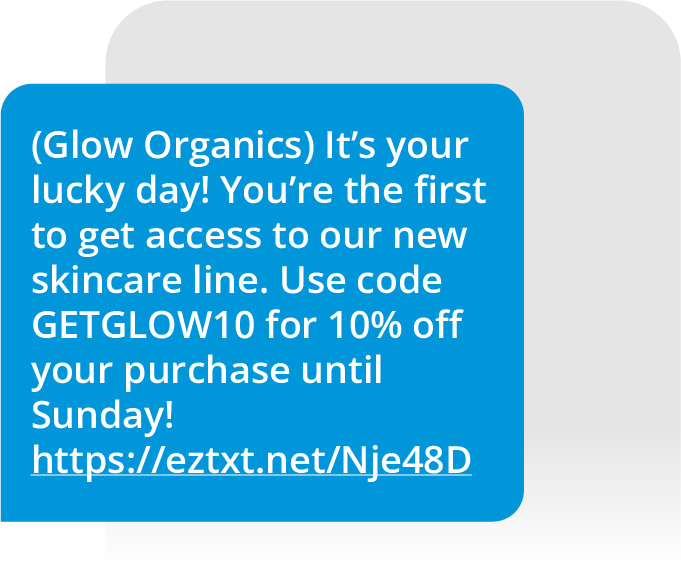SMS Marketing vs. Email Marketing: A Comparison of the Key Differences
Learn how each channel can be tailored to your audience for the most robust marketing strategy

Businesses everywhere strive to engage, delight, and retain customers through various channels. Email and SMS marketing are the dominant contenders, with almost 350 billion emails and over 23 billion texts sent daily.
But to effectively reach audiences, marketers need to understand where each channel excels, its limitations, and how to make a stellar, sales-driving strategy using both. Let’s dive into the details in this comparison guide for SMS vs. email marketing, two powerful avenues for connecting with customers.
What Are the Key Differences Between SMS Marketing & Email Marketing?
There are several key differences between SMS marketing and email marketing: open rates, deliverability, click-through rates, length, and personalization options. Learn about each difference here.

Open Rates
You’ve probably heard about the vast difference in open rates between SMS marketing vs. email marketing, if you haven’t, here’s the gist: The SMS open rate vs. email is 98% versus 18%. That’s a whopping 80% difference in whether someone will read your message or not!
Deliverability
Deliverability can refer to bounce rates (aka, was your message delivered or not) and how soon a message is read. While bounce rates of SMS and email vary depending on the quality of your contact lists, SMS and email marketing platforms can report your business’s specific bounce rates. Learn the best lead-generation tactics to ensure you’re acquiring the best contacts.
However, we can provide SMS vs. email statistics on how quickly people open messages: For text, a 2019 mobile usage report notes that 70% of people open their text messages within 5 minutes of receiving them. For email, 19% open messages upon or soon after receiving them.
Click-Through Rates
Click-through rates (CTRs) for SMS messages vary, generally around 32%. Compare that with a 10% CTR for emails. One reason for the difference in this SMS vs. email statistic could be the disparity in open rates between the two marketing channels. The more people that open your message, the more opportunities there are for people to click your message link.
Learn more about CTRs, bounce rates, and more with our handy SMS glossary.
Length
One of the most noticeable differences between SMS vs. email marketing is the length of the messages. SMS messages are limited to 160 characters, while email messages don’t have a length limit.
Additionally, MMS (multimedia messaging service) messages can exceed that 160-character limit and include images or videos. Read more about SMS vs. MMS.
Personalization Options
In the marketing world, boosting engagement is a key goal. SMS marketing does that with conversational texting, also known as two-way texting. This feature allows businesses to have personalized, one-on-one conversations with their contacts.
Email marketing does not have this capability. However, because emails have longer runways for content length, there are more opportunities to make messages personalized. Text messages, on the other hand, have to fit in personalized content along with the offer or notification and a link — all within 160 characters. If you ever find yourself stumped on how to craft the best message, consider using AI-generated content for text marketing.
SMS vs. Email: Which Is Better for Driving Sales?
To answer the question about which is better for driving sales, businesses must turn to their marketing goals. Each channel has different primary use cases.
Because of its slower (and lower) open rates, email marketing is best for nonurgent communication, like newsletters, product launches, customer surveys, and more. Text messages, on the other hand, can reach people quickly. SMS marketing is best for urgent messages, like time-sensitive promotions and offers, reminders, and alerts.
So, whether SMS marketing vs. email marketing is better for driving sales depends on the campaign's goal.
SMS vs. Email: Which Is More Cost-Effective?
To determine which is more cost-effective, email marketing vs. SMS marketing, you’ll need to take into account what’s involved in assessing costs for both channels:
- Email marketing: Email complexity (like graphics, design, etc.), email frequency (the more you send, the more you’ll spend), the platform fee.
- SMS marketing: Cost per message, cost per keyword (if using), the platform fee.
Mid-sized businesses can expect to pay up to $1,500 monthly on email marketing, but that number can change depending on the abovementioned factors. Similarly, SMS marketing can have quite a range: SMS messages cost between $0.01 to $0.05, and keywords can range from $15 to $25. Learn more about SMS ROI.
Remember that email and SMS marketing platforms often include helpful tools in their subscriptions.
SMS vs. Email: Which Is Better for Reaching a Younger Audience?
Generally speaking, SMS marketing is better for reaching a younger audience. Consumers have increasingly shorter attention spans, probably due, in part, to the incredible amount of advertising messages that cross their paths every day across social, email, and SMS channels, as well as TV.
Young audiences are used to short-form content and tend to only invest their time in something that they believe brings value. So, SMS marketing is the way to go when targeting younger generations with time-sensitive messages — but make sure that each message clearly states the value for the customer.

However, that’s not to say that email doesn’t have its place with younger crowds. Again, email marketing is your best bet when delivering longer-form content.
SMS vs. Email: Which Is More Regulated?
SMS marketing is more regulated than email marketing, and that’s due to the strict compliance laws that consumer-related text messages must follow.
The biggest regulation difference between email marketing vs. SMS marketing relates to opt-in/opt-out messages. While emails can have one little unsubscribe link at the bottom of the message, SMS marketing messages must obtain consent before sending texts and they must clearly state how to opt out. Learn the ins and outs of SMS marketing compliance with this in-depth guide.
Why You Should Use Email & SMS Marketing Together
You might wonder, "Which is better for me: SMS vs. email marketing?" But instead of asking which is better, consider which channel you should use depending on the campaign's purpose.
The best marketing strategy includes all customer touchpoints: website, social media, email, SMS, and even out-of-home advertising. So, incorporating email and SMS marketing together will create a seamless, cohesive multichannel experience for your customers.

Consider the following example: A business is launching a new skincare line. It wants to promote a limited-time offer while providing context for the new products. The business should send short SMS messages regarding the promotion and longer email messages about the launch, promotion, and background. Customers will receive information about the same marketing strategy but in formats specific to text and email.
Plus, if some customers prefer email over text messages — and vice versa — you now have a surefire way to reach both users.
While there are several critical differences between SMS marketing vs. email marketing, this best practice remains: Businesses should use both as part of their marketing strategies to reach and connect with their audiences.
FAQs
One isn’t better for customer retention than the other: Both SMS and email marketing can be used in tandem to boost customer retention through an omnichannel strategy. SMS messages can be personalized and include conversational texts, while email can provide longer-form content about customer loyalty programs, promotions, and more.
Email marketing is generally easier to measure the results of than SMS marketing only because the analytics reports are often more robust. SMS marketing platforms, like EZ Texting, include reporting dashboards to measure campaigns, but these cannot include analytics on SMS open rates due to compliance laws.
Because SMS messages are delivered more reliably than email messages in some countries, SMS marketing is generally better for international marketing than email marketing.
SMS marketing is generally better for mobile marketing than email marketing because SMS messages are delivered directly to people's mobile phones. However, 85% of people use mobile phones to open emails, meaning that email marketing is another great way to reach mobile users.
See other resources related to:
